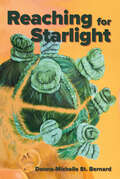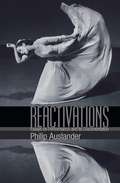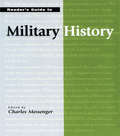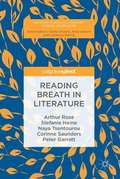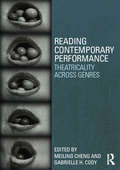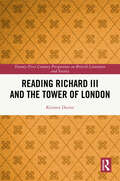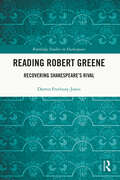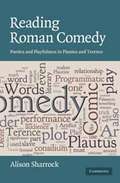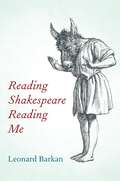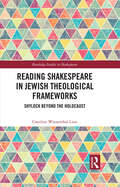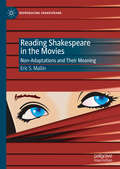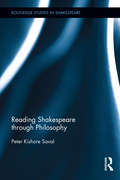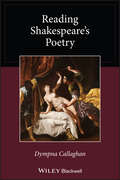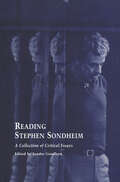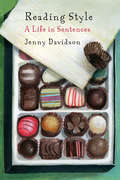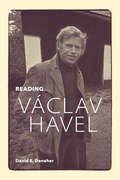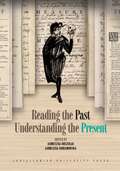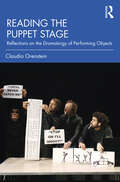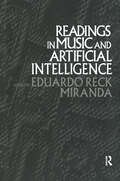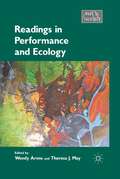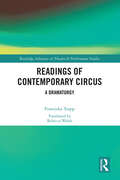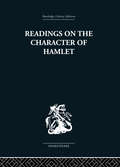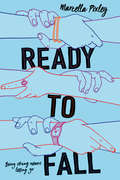- Table View
- List View
Reaching for Starlight
by Donna-Michelle St. BernardReenie wants to dance, following in her mother’s footsteps. Just like the rest of her ensemble, she believes she has what it takes to earn the coveted solo at the year-end recital. But when she notices that their strict maestra is not holding everyone to the same “traditional” standard—particularly Maia, the other Black girl in the class—Reenie is determined to stop her friend from being counted out of the competition. Frustrated with not being understood by her mother and filled with a new-found passion to fight a broken system, Reenie hatches a plan with her classmates but doesn’t realize where her quick journey towards justice missed the mark with her friend.Reaching for Starlight is a compassionate story about the way we are told to move through a world not made for us, whether together or alone.
Reactivations: Essays on Performance and Its Documentation
by Philip AuslanderMost people agree that witnessing a live performance is not the same as seeing it on screen; however, most of the performances we experience are in recorded forms. Some aver that the recorded form of a performance necessarily distorts it or betrays it, focusing on the relationship between the original event and its recorded versions. By contrast, Reactivations focuses on how the audience experiences the performance, as opposed to its documentation. How does a spectator access and experience a performance from its documentation? What is the value of performance documentation? The book treats performance documentation as a specific discursive use of media that arose in the middle of the 20th century alongside such forms of performance as the Happening and that is different, both discursively and as a practice, from traditional theater and dance photography. Philip Auslander explores the phenomenal relationship between the spectator who experiences the performance from the document and the document itself. The document is not merely a secondary iteration of the original event but a vehicle that gives us meaningful access to the performance itself as an artistic work.
Reader's Guide to Military History (Reader's Guiides Ser.)
by Charles MessengerThis book contains some 600 entries on a range of topics from ancient Chinese warfare to late 20th-century intervention operations. Designed for a wide variety of users, it encompasses general reviews of aspects of military organization and science, as well as specific wars and conflicts. The book examines naval and air warfare, as well as significant individuals, including commanders, theorists, and war leaders. Each entry includes a listing of additional publications on the topic, accompanied by an article discussing these publications with reference to their particular emphases, strengths, and limitations.
Reading Breath in Literature (Palgrave Studies in Literature, Science and Medicine)
by Peter Garratt Arthur Rose Stefanie Heine Naya Tsentourou Corinne SaundersThis open access book presents five different approaches to reading breath in literature, in response to texts from a range of historical, geographical and cultural environments. Breath, for all its ubiquity in literary texts, has received little attention as a transhistorical literary device. Drawing together scholars of Medieval Romance, Early Modern Drama, Fin de Siècle Aesthetics, American Poetics and the Postcolonial Novel, this book offers the first transhistorical study of breath in literature. At the same time, it shows how the study of breath in literature can contribute to recent developments in the Medical Humanities.
Reading Contemporary Performance: Theatricality Across Genres
by Meiling Cheng Gabrielle H. CodyAs the nature of contemporary performance continues to expand into new forms, genres and media, it requires an increasingly diverse vocabulary. Reading Contemporary Performance provides students, critics and creators with a rich understanding of the key terms and ideas that are central to any discussion of this evolving theatricality. Specially commissioned entries from a wealth of contributors map out the many and varied ways of discussing performance in all of its forms – from theatrical and site-specific performances to live and New Media art. The book is divided into two sections: Concepts - Key terms and ideas arranged according to the five characteristic elements of performance art: time; space; action; performer; audience. Methodologies and Turning Points - The seminal theories and ways of reading performance, such as postmodernism, epic theatre, feminisms, happenings and animal studies. Case Studies – entries in both sections are accompanied by short studies of specific performances and events, demonstrating creative examples of the ideas and issues in question. Three different introductory essays provide multiple entry points into the discussion of contemporary performance, and cross-references for each entry also allow the plotting of one’s own pathway. Reading Contemporary Performance is an invaluable guide, providing not just a solid set of familiarities, but an exploration and contextualisation of this broad and vital field.
Reading Hebron
by Jason ShermanA Toronto Jew named Nathan Abramowitz investigates the Hebron Massacre - in which a Jewish settler murdered 29 Muslims at prayer - as a way of questioning his own responsibility for the oppression of Palestinians.
Reading Modern Drama
by Alan AckermanExploring the relationship between dramatic language and its theatrical aspects, Reading Modern Drama provides an accessible entry point for general readers and academics into the world of contemporary theatre scholarship. This collection promotes the use of diverse perspectives and critical methods to explore the common theme of language as well as the continued relevance of modern drama in our lives.Reading Modern Drama offers provocative close readings of both canonical and lesser-known plays, from Hedda Gabler to e.e. cummings' Him. Taken together, these essays enter into an ongoing, fruitful debate about the terms 'modern' and 'drama' and build a much-needed bridge between literary studies and performance studies.
Reading Richard III and the Tower of London (21st Century Perspectives on British Literature and Society)
by Kristen DeiterThis is the first book on Richard III and the Tower of London, shedding new light on the King’s reputation, the Castle’s lore, and early modern literature’s role in building associations between them. It is also one of the first books to integrate conceptual blending theory and spatial literary studies, empowering scholars and students to analyze literature and locations in new ways. This book fills gaps in the existing knowledge about both Richard III and the Tower of London. Neither literary nor historical scholarship has treated the process through which Richard III and the Tower became associated in the cultural and historical imagination and how such representations have shaped the King’s reputation and the Castle’s lore. This study analyzes this process while offering new understandings of Richard III as a literary character in prose, drama, and poetry and extending knowledge about the Tower as an iconic literary and cultural symbol.
Reading Robert Greene: Recovering Shakespeare’s Rival (Routledge Studies in Shakespeare)
by Darren Freebury-JonesRobert Greene holds a significant place in our understanding of Elizabethan literature. This book offers the most rigorous attempt yet undertaken to determine the scope of the playwright’s canon through analyses of Greene’s verse style, vocabulary, rhyming habits, and the dramatist’s phraseology in his attested plays and in comparison to four plays that have long been on the margins of Greene’s corpus: Locrine, Selimus, George a Greene, and A Knack to Know a Knave. The book defines the ranges for Greene’s stylistic habits for the very first time, and proceeds to identify parallels of thought, language, and overall dramaturgy that reveal a single author’s creative consciousness. This volume also casts light on Greene as a more collaborative dramatist than has hitherto been acknowledged. Through emphasizing the immediate surroundings in which Greene was writing – the flourishing of popular theatres in two compact areas of London, in which each theatre company and their dramatists kept a close eye on what their competitors were producing – Greene emerges as an influential playwright, whose restored oeuvre enables us to establish new ways in which his dramatic methods impacted other writers of the period, including Shakespeare.
Reading Roman Comedy: Poetics and Playfulness in Plautus and Terence
by Alison SharrockFor many years the domain of specialists in early Latin, in complex metres, and in the reconstruction of texts, Roman comedy has only recently begun to establish itself in the mainstream of Classical literary criticism. Where most recent books stress the original performance as the primary location for the encountering of the plays, this book finds the locus of meaning and appreciation in the activity of a reader, albeit one whose manner of reading necessarily involves the imaginative reconstruction of performance. The texts are treated, and celebrated, as literary devices, with programmatic beginnings, middles, ends, and intertexts. All the extant plays of Plautus and Terence have at least a bit part in this book, which seeks to expose the authors' fabulous artificiality and artifice, while playing along with their differing but interrelated poses of generic humility.
Reading Shakespeare Reading Me
by Leonard BarkanA gripping, funny, joyful account of how the books you read shape your own life in surprising and profound ways.Bookworms know what scholars of literature are trained to forget: that when they devour a work of literary fiction, whatever else they may be doing, they are reading about themselves. Read Shakespeare, and you become Cleopatra, Hamlet, or Bottom. Or at the very least, you experience the plays as if you are in a small room alone with them, and they are speaking to your life, your sensibility.Drawing on fifty years as a Shakespearean, Leonard Barkan has produced a captivating book that asks us to reconsider what it means to read. Barkan violates the rule of distance he was taught and has always taught his students. He asks: Where does this brilliantly contrived fiction actually touch me? Where is Shakespeare in effect telling the story of my life?King Lear, for Barkan, raises unanswerable questions about what exactly a father does after planting the seed. Mothers from Gertrude to Lady Macbeth are reconsidered in the light of the author’s experience as a son of a former flapper. The sonnets and comedies are seen through the eyes of a gay man who nevertheless weeps with joy when all the heterosexual couples are united at the end. A Midsummer Night’s Dream is interpreted through the author’s joyous experience of performing the role of Bottom and finding his aesthetic faith in the pantheon of antiquity. And the exquisitely poetical history play Richard II intersects with, of all things, Ru Paul’s Drag Race.Full of engrossing stories, from family secrets to the world of the theater, and written with humor and genuine excitement about literary experiences worthy of our attention and our love, Reading Shakespeare Reading Me makes Shakespeare’s plays come alive in new ways.
Reading Shakespeare in Jewish Theological Frameworks: Shylock Beyond the Holocaust (Routledge Studies in Shakespeare)
by Caroline Wiesenthal LionReading Shakespeare in Jewish Theological Frameworks: Shylock Beyond the Holocaust uses Jewish theology to mount a courageous new reading of a four-hundred-year-old play, The Merchant of Venice. While victimhood and antisemitism have been the understandable focus of the Merchant critical history for decades, Lion urges scholars, performers, and readers to see beyond the racism in Shakespeare's plays by recovering Shakespearean themes of potentiality and human flourishing as they emerge within the Jewish tradition itself. Lion joins the race conversation in Shakespeare studies today by drawing on the intellectual history and oppression of the Jewish people, borrowing from thinkers Franz Rosenzweig and Abraham Joshua Heschel as well as Hannah Arendt, Walter Benjamin, Jacques Derrida, Emmanuel Levinas, and rabbis from the Talmud to today. This volume interweaves post-confessional, Protestant, Catholic, Muslim, Jewish, and mystical ideas with Shakespeare's poetry and opens conversations of prophecy, love, spirituality, care, and community. It concludes with brief critical sketches of Antony and Cleopatra, Hamlet, and Macbeth to demonstrate that Shakespeare when interpreted through Jewish theological frameworks can point to post-credal solutions and transformed societal paradigms of repair that encourage action and the shaping of a finer world.
Reading Shakespeare in the Movies: Non-Adaptations and Their Meaning (Reproducing Shakespeare)
by Eric S. MallinReading Shakespeare in the Movies: Non-Adaptations and Their Meaning analyzes the unacknowledged, covert presence of Shakespearean themes, structures, characters, and symbolism in selected films. Writers and directors who forge an unconscious, unintentional connection to Shakespeare’s work create non-adaptations, cinema that is unexpectedly similar to certain Shakespeare plays while remaining independent as art. These films can illuminate core semantic issues in those plays in ways that direct adaptations cannot. Eric S. Mallin explores how Shakespeare illuminates these movies, analyzing the ways that The Godfather, Memento, Titanic, Birdman, and The Texas Chainsaw Massacre take on new life in dialogue with the famous playwright. In addition to challenging our ideas about adaptation, Mallin works to inspire new awareness of the meanings of Shakespearean stories in the contemporary world.
Reading Shakespeare through Philosophy: Reading Shakespeare Through Philosophy (Routledge Studies in Shakespeare)
by Peter Kishore SavalReading Shakespeare through Philosophy advocates that the beauty of Shakespearean drama is inseparable from its philosophical power. Shakespeare’s plays make demands on us even beyond our linguistic attention and historical empathy: they require thinking, and the concepts of philosophy can provide us with tools to aid us in that thinking. This volume examines how philosophy can help us to re-imagine Shakespeare’s treatment of individuality, character, and destiny, particularly at certain moments in a play when a character’s relationship to space or time becomes an enigma to us. The author focuses on the dramatization of seemingly magical relationships between the individual and the cosmos, exploring and rethinking the meanings of 'individual', 'cosmos' and 'magic' through a conceptually acute reading of Shakespeare's plays. This book draws upon a variety of thinkers including Plato, Aristotle, Leibniz and Kant, in search of a revitalized philosophical criticism of Julius Caesar, Love’s Labor’s Lost, The Merchant of Venice, Timon of Athens, and Twelfth Night.
Reading Shakespeare's Poetry (Wiley Blackwell Reading Poetry)
by Dympna CallaghanReading Shakespeare’s Poetry A lively exploration of Shakespeare’s poems and how they speak to readers Reading Shakespeare’s Poetry presents a fresh interpretation of Shakespeare’s non-dramatic poems, providing insights into the individual poems, their themes and composition, and their relation to the cultural context of Shakespeare’s world. Dympna Callaghan considers what makes Shakespeare’s language poetic and shows how his poetry is comprised not only of lyrical intensity but also of the language of everyday life. Presented chronologically, lucidly-written chapters examine Venus and Adonis, Lucrece, The Phoenix and the Turtle, the Sonnets, and A Lover’s Complaint. Special attention is paid to the distinctive ways in which lineation, rhyme, verse forms, and meter serve to delineate or erase the boundaries of Shakespeare’s poetry. Throughout the book, the author explains how Shakespeare’s language is influenced by predecessors such as Ovid and Petrarch while highlighting how ideas about the social and cultural function of poetry permeate Shakespeare’s works. Offers an eminently readable yet scholarly exploration of the literary importance of Shakespeare’s poems Explains the technical features of Shakespeare’s poetic language Addresses the significance of the material form in which Shakespeare’s poems appear Includes a discussion of songs, poems, and sonnets embedded in Shakespeare’s dramatic verse Reading Shakespeare’s Poetry is both a fresh and indispensable guide to the poems and a significant critical intervention. This is a must-have book for scholars, students, and general readers alike.
Reading Stephen Sondheim: A Collection of Critical Essays (Studies in Modern Drama #Vol. 10)
by Sandor GoodhartFirst Published in 2000. Routledge is an imprint of Taylor & Francis, an informa company.
Reading Style
by Jenny DavidsonA professor, critic, and insatiable reader, Jenny Davidson investigates the passions that drive us to fall in love with certain sentences over others and the larger implications of our relationship with writing style. At once playful and serious, immersive and analytic, her memoir/critique shows how style elicits particular kinds of moral judgments and subjective preferences, which turn reading into a highly personal and political act.Melding her experiences as reader and critic, Davidson opens new vistas onto works by Jane Austen, Henry James, Marcel Proust, and Thomas Pynchon; adds richer dimension to critiques of W. G. Sebald, Alan Hollinghurst, Thomas Bernhard, and Karl Ove Knausgaard; and allows for a sophisticated appreciation of popular fictions by Stephen King, Neil Gaiman, Lionel Shriver, George Pelecanos, and Helen DeWitt. She privileges diction, syntax, point of view, and structure over plot and character, identifying the intimate mechanics that draw us in to literature's sensual frameworks and move us to feel, identify, and relate. Davidson concludes with a reading list of her favorite titles so others can share in her literary adventures and get to know better the imprint of her own reading style.
Reading Václav Havel
by David S. DanaherAs a playwright, a dissident, and a politician, Václav Havel was one of the most important intellectual figures of the late twentieth century. Working in an extraordinary range of genres - poetry, plays, public letters, philosophical essays, and political speeches - he left behind a range of texts so diverse that scholars have had difficulty grappling with his oeuvre as a whole.In Reading Václav Havel, David S. Danaher approaches Havel's remarkable body of work holistically, focusing on the language, images, and ideas which appear and reappear in the many genres in which Havel wrote. Carefully reading the original Czech texts alongside their English versions, he exposes what in Havel's thought has been lost in translation. A passionate argument for Havel's continuing relevance, Reading Václav Havel is the first book to capture the fundamental unity of his vast literary legacy.
Reading the Past, Understanding the Present
by Agnieszka Orszulak Agnieszka RomanowskaReading the Past, Understanding the Present is a collection of essays written by students from nine European universities, who took part in the Strategic Partnership, “Facing Europe in Crisis: Shakespeare’s World and Present Challenges,” aiming to promote historical understanding of the crises plaguing the contemporary Europe and the world. In each chapter, the authors examine early modern theatre, the works by William Shakespeare in particular, and how it interacts with various local and global issues, reflecting on their cultural and socio-political origins and consequences. This book offers an innovative insight into the relationship between the past represented in such plays as The Merchant of Venice, King Lear, The Tempest</i, or the history plays and the complex contemporary European context – migrant crisis, racial diversity, democracy, or the Covid-19 pandemic.
Reading the Puppet Stage: Reflections on the Dramaturgy of Performing Objects
by Claudia OrensteinDrawing on the author’s two decades of seeing, writing on, and teaching about puppetry from a critical perspective, this book offers a collection of insights into how we watch, understand, and appreciate puppetry. Reading the Puppet Stage uses examples from a broad range of puppetry genres, from Broadway shows and the Muppets to the rich field of international contemporary performing object experimentation to the wealth of Asian puppet traditions, as it illustrates the ways performing objects can create and structure meaning and the dramaturgical interplay between puppets, performers, and language onstage. An introductory approach for students, critics, and artists, this book underlines where significant artistic concerns lie in puppetry and outlines the supportive networks and resources that shape the community of those who make, watch, and love this ever-developing art.
Readings in Music and Artificial Intelligence (Contemporary Music Studies #20)
by Eduardo Reck MirandaFirst published in 2000. Routledge is an imprint of Taylor & Francis, an informa company.
Readings in Performance and Ecology
by Wendy Arons Theresa J. MayThis ground-breaking collection focuses on how theatre, dance, and other forms of performance are helping to transform our ecological values. Top scholars explore how familiar and new works of performance can help us recognize our reciprocal relationship with the natural world and how it helps us understand the way we are connected to the land.
Readings of Contemporary Circus: A Dramaturgy (ISSN)
by Franziska TrappWhat are the characteristics of contemporary circus? In what way does contemporary circus differ from theater, dance, and performance? Where do hybrid forms exist? Where are there observable commonalities? Despite the diversity of contemporary circus performances, are there generalizable characteristics that unite the performances? What potential do these questions have for dramaturgical practice?This book adapts a cultural-semiotic approach to analyze contemporary circus performances. It offers the first comprehensive documentation and interpretation of the art form based on the reading theories of cultural, literature, theater, and dance studies. The volume thereby provides a dramaturgy of contemporary circus, which reveals its generalizable characteristics, fundamental techniques and structures, and the effects they produce. At the same time, theories and methods are modified and further developed regarding the characteristics of the circus.This book is designed for students and scholars in the field of theater and performance studies, as well as for artists, dramaturges, and directors working in the field of circus.
Readings on the Character of Hamlet: compiled from over three hundred sources.
by Claude C WilliamsonFirst published in 1950. This volume contains the essence of over three hundred well-known literary critics who, between 1661 and 1947, considered the great literary riddle of the years · Entries arranged chronologically by date of publication· International authorship of material
Ready to Fall: A Novel
by Marcella PixleyA young adult novel about a teen who finds hope and a fresh start after a terrible loss, and learns that being strong means letting go.When Max Friedman’s mother dies of cancer, instead of facing his loss, Max imagines that her tumor has taken up residence in his brain. It's a terrible tenant—isolating him from family, distracting him in school, and taunting him mercilessly about his manhood. With the tumor in charge, Max implodes, slipping farther and farther away from reality. Finally, Max is sent to the artsy, off-beat Baldwin School to regain his footing. He joins a group of theater misfits in a steam-punk production of Hamlet where he becomes friends with Fish, a girl with pink hair and a troubled past, and The Monk, an edgy upperclassman who refuses to let go of the things he loves. For a while, Max almost feels happy. But his tumor is always lurking in the wings—until one night it knocks him down and Max is forced to face the truth, not just about the tumor, but about how hard it is to let go of the past. At turns lyrical, haunting, and triumphant, Ready to Fall is a story of grief, love, rebellion and starting fresh from acclaimed author Marcella Pixley.
